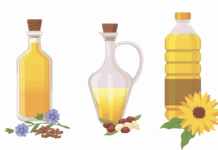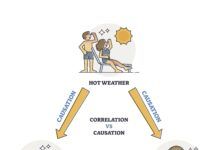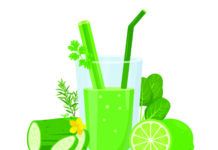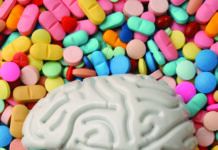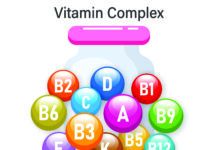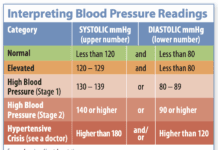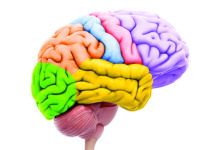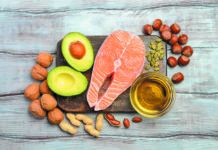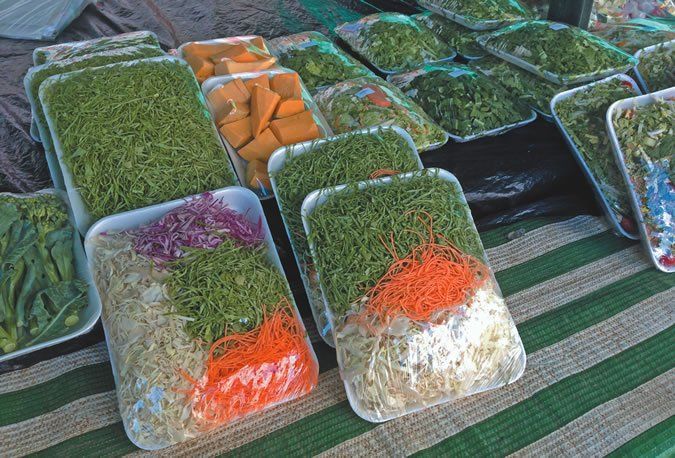
Image © Luisrftc | Dreamstime.com
Getting older brings significant changes—in where you live, how you live and with whom you live. New health conditions and age-related changes in the body can affect how well you absorb certain nutrients and the amounts you may need. Although you can’t stop time, you can control what you eat.
“For people who want to stay as healthy as possible, for as long as possible, and prevent conditions that affect their quality of life, we know that nutrition plays an important role,” says Diane L. McKay, PhD, Assistant Professor in the Friedman School of Nutrition Science and Policy and consulting editor for The Healthy-Aging Diet, a Special Report by the editors of Tufts Health & Nutrition Letter.
Fortunately, it’s never been easier to maintain a healthy eating pattern throughout life. If the number of mouths to feed in your household has decreased to one or two, you may have to learn a different way to shop and cook to prevent food waste.
It helps to take advantage of convenient and flexible options such as frozen fruits and vegetables, precut produce and pre-portioned protein sources like chicken breasts and salmon fillets. “Keep it simple,” McKay says. “You don’t need to do a whole lot of cooking and preparing in order to make a nutritious meal, and herbs and spices help keep things tasty. After all, it’s about enjoying your foods. If it doesn’t taste good, you’re not going to eat it.”
How Nutrient Needs Change With Age: Changes in the body and certain increased health risks mean you need to make sure that your diet provides the energy you need and adequate amounts of certain nutrients of particular importance to older adults.
Focus On Nutrient Dense Foods. The need for calories decreases somewhat with aging because people generally become less physically active and may start to lose muscle mass. Because muscle is more metabolically active and burns more calories than other types of body tissue, having less muscle can reduce the amount of energy required daily.
Even if you need fewer calories, you still need adequate levels of nutrients. It becomes more important to choose foods that are more nutrient dense—concentrated sources of vitamins, minerals, fiber, protein and other essentials. In general, nutrient-dense choices are more likely to be whole foods, which contain all the fiber and little or no added sugar and salt.
Nutrient dense foods include fruits, vegetables, whole grains, beans, nuts, seafood, lean poultry and meat, dairy products and eggs. Snack foods, such as potato chips, corn chips, sugary beverages and baked goods made from refined grains, are less likely to be nutrient dense.
Obtain Key Nutrients. Certain nutrients are of particular importance to older adults, either because of difficulty absorbing them from food or because they help maintain a healthy body. These key nutrients include:
- Vitamin B12.Many older adults develop below-normal levels of B12, in part because the stomach produces less acid, which is needed to separate B12 from foods. “You could conceivably be eating plenty of B12-rich foods in your diet and yet not absorbing enough,” McKay says. To compensate, the Institute of Medicine recommends that you eat breakfast cereals with B12 or get it from a supplement, such as a multivitamin.
- Calcium.With aging, we start to lose some of the calcium that was stored in our bones earlier in life. “After that point, if you don’t get enough calcium, you are not going to have strong enough bones to last your lifetime.” Obtain as much of your daily calcium needs as possible from dietary sources, such as fat-free or low-fat yogurt, spinach, kale andsardines.
- Vitamin D.Vitamin D helps the body absorb calcium. However, as we age, the body’s ability to produce vitamin D naturally in the skin declines. At the same time, you may be exposed less to direct sunlight by covering up and wearing sunscreen to reduce the risk of skin cancer. But you can get vitamin D from fortified milk, fortified breakfast cereals, fortified orange juice or from a supplement.
- Potassium.Potassium is important for heart health, good muscle function and preventing high blood pressure. Bananas are just one popular food that supplies potassium. “Other good sources include fish and plant foods, primarily legumes, vegetables andfruits,” McKay says. “In fact, in a typical Americandietthe highest sources of potassium are actually canned tomatoes, coffeeandmilk.”
- Iron.Decreased stomach acid can also affect the ability to absorb iron from foods. “The iron that you find in animal-based foods is more readily absorbed than the iron that you find in plant-based foods,” McKay says. “Therefore, if you are consuming a vegetarian diet, you need to make sure that you’re getting enough iron.” Lentils, beans andspinach are goodplantsources of iron. Among animal foods, top iron-rich foods include beef and chicken liver and canned sardines.
- Fiber.As you get older, the gastrointestinal tract may function less efficiently. This can lead to constipation, but getting enough dietary fiber can help. Adequate fiber intake has also been linked to lower risks of cardiovascular disease, diabetes andcolorectal cancer. Fruits, vegetablesandwhole grains are all good sources of fiber and have other health benefits as well.
- Fluids.In general, the sense of thirst diminishes somewhat with age, so you may need to pay closer attention to getting enough fluids to prevent dehydration. Water is also important when consuming fiber because it helps fiber bulk up and keeps waste moving through your intestines.
Follow a Healthy Eating Pattern: An overall healthy eating pattern can provide all or most of the nutrients you need. The most evidence-based guide for establishing a healthy eating pattern in the US population is the 2015-2020 Dietary Guidelines for Americans. It’s based on a comprehensive review of the best scientific information about healthy eating available. As defined by the Scientific Report of the 2015 Dietary Guidelines Advisory Committee, a dietary pattern means “the quantities, proportions, variety or combinations of different foods and beverages in diets, and the frequency with which they are habitually consumed.”
A healthy eating pattern is substantially based on whole, minimally modified plant foods. That pattern includes:
- A variety of vegetables, though don’t load up on starchy types like white potatoes.
- Fruits, especially whole fruits.
- Grains, at least half of which are whole grains.
- Fat-free or low-fat dairy, including milk, yogurt, cheese and/or fortified soy beverages.
- A variety of protein foods, including seafood, lean meats and poultry, eggs, legumes (beans and peas), nuts, seeds and soy products.
- Oils, including those from plants such as canola, corn, olive, peanut, safflower, soybeanandsunflower, as well as those naturally present in nuts, seeds, olives, seafood and avocados.
- Limited amounts of processed meat (and substitute red meat with other options, such as skinless poultry and fish), added sugar and salt.
To help guide food choices, nutrition scientists at the Human Nutrition Research Center on Aging (HNRCA) at Tufts University have developed the
MyPlate for Older Adults. (See illustration at below.) It offers some general guidelines for following a healthy eating pattern.
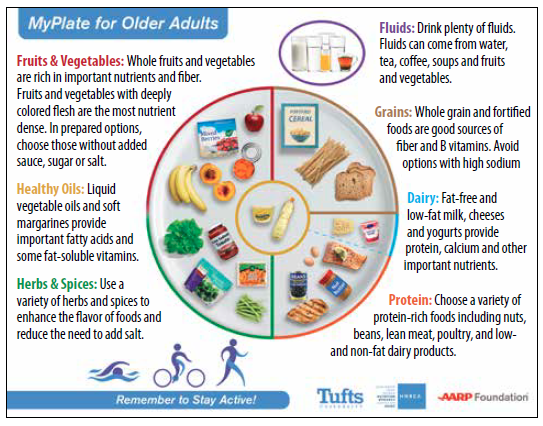
Make Good Choices Every Day: There is no one eating pattern that is a good fit for everyone. What you eat depends on multiple factors, including your cooking skills and interest in food preparation, food availability, and your personal tastes and the culture you grew up in.
One thing is certain: Every decision you make matters. They can add up to a healthy dietary pattern—or an unhealthy one. The choice is yours. Here are some general guidelines:
- Sodium:Americans get most of their sodium from prepared foods, not the salt shaker. TheDietary Guidelinesrecommend limiting your daily intake of sodium to 2,300 milligrams—the amount in about 1 teaspoon of table salt. The solution is not keeping count of your sodium intake, but taking commonsense steps to reduce your intake in multiple ways. When shopping or ordering at restaurants, choose lower-sodium options if they are available and eat fewer or smaller portions of foods that are particularly high in sodium. The Nutrition Facts labels on packaged foods tell you how much sodium it contains per serving. Revised labels that will be implemented in the next few years will include more realistic estimates of the portions (and sodium content) of foods that Americans typically consume.
- Saturated fat:Research shows that consuming more unsaturated fats, relative to saturated fats, is associated with lower risk of cardiovascular disease. The way to keep things in balance comes down to day-to-day choices, like choosing leaner cuts of red meat and nonfat or low-fat dairy foods and salad dressings made with liquid vegetable oils.
- Added sugar:Consuming foods with high levels of added sugars is associated with greater risk of becoming overweight and developing heart disease and type 2 diabetes. Most added sugars in the American diet come from sugar-sweetened beverages, snacksandsweets. Substitute snacks of whole fruits and vegetables (apple slices, baby carrots, etc.) for foods made with refined ingredients, like chips and cookies. (Fruit has sugar, of course, but it comes with all the other nutrients in the “package.”) Identifying foods with higher amounts of added sugar will become easier as manufacturers roll out revised nutrition labels that specifically state the amounts of added sugar in their products.
- Processed meat:Eating more processed meats, relative to less-processed meats, is associated with higher risk for cardiovascular disease and cancer. According to theDietary Guidelines, processed meats include red meat, poultry, or seafood products preserved by smoking, curing or salting,andadditionof chemical preservatives. They include bacon, sausage, hot dogs, sandwich meat, packaged ham, pepperoniandsalami. Eat processed meats less often and in smaller portions.
Changes and Opportunities: Older age need not be a time when you have to deny yourself your favorite foods to address concerns about heart health and weight gain. It’s also a time of new opportunities—to cook, to exercise and to use meals to rekindle old friendships and make new social connections.
Many people believe that chronic diseases are an inevitable part of aging—that heart attack, stroke, cancer, type 2 diabetes, kidney disease, and arthritis are eventually going to affect them. But many of these conditions are preventable, and, even in later life, you can reduce your risks and treat these conditions to keep them manageable. According to the Centers for Disease Control and Prevention, five of the 10 leading causes of death for individuals over age 60 are conditions that benefit from changes in diet. Fortunately, eating habits are within your control.
“There are no data to suggest a person is too old to benefit from improvements in diet quality,” says Alice H. Lichtenstein, DSc, director of Tufts’ HNRCA Cardiovascular Nutrition Laboratory and executive editor of Tufts Health & Nutrition Letter. “Changes don’t have to be drastic or difficult. Gradual shifts in food choices towards healthier options and small but sustained increases in physical activity can add up and be very meaningful in the long term.”

